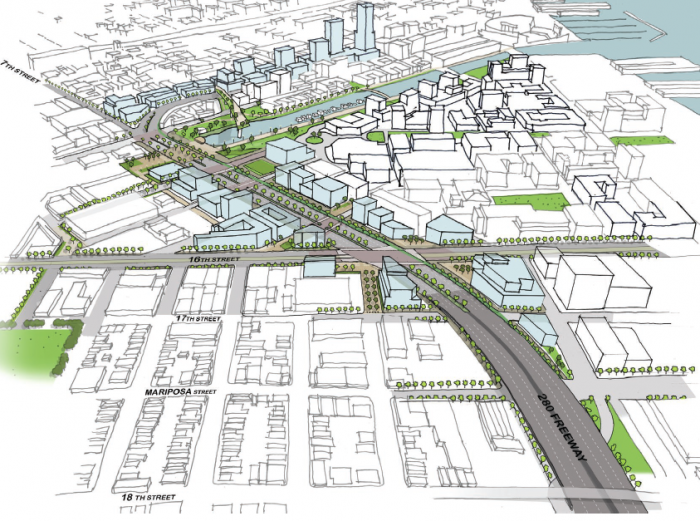Background
When the City of San Francisco chose to demolish rather than rebuild two earthquake-damaged freeways in 1989, it began a historic natural experiment in urban planning. Ultimately, that example would prove to the world that removing in-city highways could boost quality of life, economic development, and housing affordability.
Now, the City is looking toward its first fully voluntary freeway removal: 1.2-mile spur of I-280, north of 16th Street, which currently links US 101 to Mission Bay.
Proposal
Just as the property tax base rose and thousands of units of affordable housing were added after the Embarcadero and Central Freeway came down, removing the I-280 Spur would open new opportunities for market-rate and affordable development in the City’s urban core.
The removal of the I-280 Spur and its replacement with a surface boulevard has been endorsed by former San Francisco Mayor Ed Lee and studied by Bay Area nonprofit SPUR. In December 2012, a report by the City of San Francisco Planning Department compared the direct costs and benefits of replacing I-280 with a modern highway versus converting it to an urban boulevard alongside the redevelopment of the 4th/King Railyards.
Crucially for San Francisco, this project could reconnect severed neighborhoods like Mission Bay, Potrero Hill, and SoMa. Once-undesirable land would be opened up to new housing and commercial development. In the face of the Bay Area’s housing crisis, this development could copy the highly successful Market & Octavia Area Plan—using diverse housing types and mixed-use buildings to fit into the established character of the neighborhood.
Moreover, the removal of the spur could serve as a catalyst for transformative projects such as the recently opened Transbay Transit Center and a possible high-speed rail station where I-280 currently terminates. The freeway removal project, with its considerable political will and likely high return on investment, is a critical first step.
A new neighborhood at the 4th and King Street railyards is one of many opportunities offered by the removal of the I-280 spur. “Together, these facilities consume more than 30 acres (about 1.3 million square feet) and represent antiquated uses in high value area,” wrote Gillian Gillett, the City’s transportation director, in a memo to Caltrain, which runs a commuter rail line on the San Francisco peninsula. “These sites also become the catalyst for the next round of center city job creation.”

Current Plans
The Railyard Alternatives and I-280 Boulevard Feasibility Study, released in 2018, claimed that the I-280 removal was unnecessary to bring Caltrains tunnels into Mission Bay, one of the major benefits claimed by removal proponents.
Many, including State Senator Scott Wiener, remain undeterred by the study’s findings and believe I-280 spur removal should stay on the table. The City has faced similar opposition and fear of traffic chaos in past in-city highway removal efforts, only to see significant benefits when the removals are complete.


















